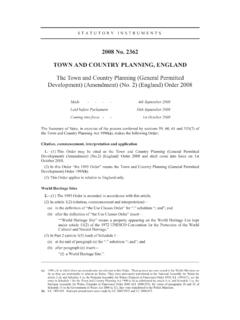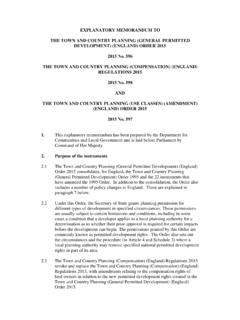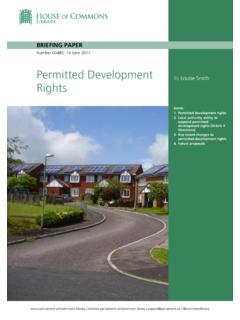Transcription of Plain English guide to the Planning System
1 January 2015 Department for Communities and Local Government Plain English guide to the Planning System 2 Crown copyright, 2014 Copyright in the typographical arrangement rests with the Crown. You may re-use this information (not including logos) free of charge in any format or medium, under the terms of the Open Government Licence. To view this licence, or write to the Information Policy Team, The National Archives, Kew, London TW9 4DU, or email: This document/publication is also available on our website at If you have any enquiries regarding this document/publication, complete the form at or write to us at: Department for Communities and Local Government Fry Building 2 Marsham Street London SW1P 4DF Telephone: 030 3444 0000 For all our latest news and updates follow us on Twitter: January 2015 ISBN.
2 978-1-4098-4321-4 3 Contents Introduction- the purpose of the Planning System 4 Key decision-takers in the Planning System 4 National Planning policy 7 Nationally significant infrastructure projects 8 Strategic Planning 9 Local Plans 10 Neighbourhood Planning 11 Contributions and community benefits 12 Permitted development rights 13 Obtaining Planning permission 13 Planning enforcement 15 Planning appeals, recovery and call-in 15 Annex A, Stages in a Local Plan 18 Annex B, Stages in a neighbourhood plan or order 19 Annex C, Stages in the Planning application process 204 Introduction- the purpose of the Planning System 1.
3 This guide explains how the Planning System in england works. It is intended to give an overview only and does not set out new Planning policy or guidance. We have done our best to ensure that the information in this guide is correct as of January 2015. It is possible that some of the information is oversimplified, or may become inaccurate over time, for example because of changes to the law. Planning Guidance can be accessed online via the Planning Portal. 2. Planning ensures that the right development happens in the right place at the right time, benefitting communities and the economy. It plays a critical role in identifying what development is needed and where, what areas need to be protected or enhanced and in assessing whether proposed development is suitable.
4 3. This Government s Planning reforms have: ensured that Planning enables sustainable development delivering the homes and jobs communities need simplified the Planning System enabled Planning decisions to be taken at the lowest possible level with the involvement of local people, and ensured strong protections are in place to conserve and enhance our valuable natural and historic environment. Key decision-takers in the Planning System Local Planning authorities 4. The Planning System is designed to be applied by local government and communities. Many parts of england have three tiers of local government: County councils District, borough or city councils Parish or town councils 5 5. Local government administers much of the Planning System , preparing Local Plans, determining Planning applications and carrying out enforcement against unauthorised development.
5 6. District councils are responsible for most Planning matters, other than transport and minerals and waste Planning which are typically functions of the county council. In some areas of the country single tier authorities have responsibility for both district level and county level Planning matters. In London the Mayor also has powers to determine certain Planning applications of potential strategic importance. In a national park, Planning functions are carried out by the park authority. 7. Where they exist, parish and town councils play an important role in commenting on Planning applications that affect their area. The Government wants to see Planning decisions taken at the lowest level possible and has introduced the ability for parish and town councils to produce neighbourhood plans which, once in force, will form part of the policies used to make decisions on applications, and neighbourhood development orders which grant permission for development directly.
6 Where parish or town councils do not exist, representatives of the local community may apply to establish a neighbourhood forum to prepare a neighbourhood plan or order. Single tier authorities London Boroughs Unitary authorities National Park Authorities County councils District councils 6 Councillors 8. Local people should take the lead in shaping their neighbourhoods and elected councillors have a key leadership role in this process. The role of councillors in district, county or single tier councils will vary depending on whether they sit on the Planning committee (which makes decisions on Planning applications) or not. However, all councillors have a role to play in representing the views and aspirations of residents in plan-making and when Planning applications affecting their ward are being considered.
7 9. Changes in the Localism Act 2011 clarified the ability of councillors to be able to discuss matters which may relate to a Planning application prior to voting on that application at committee, as long as they can show that they are going to make their judgement on the application with an open mind, listening to all the evidence and not having pre-determined their decision. 10. Further information on probity in Planning can be found on the Planning Advisory Service s website. Officers 11. Local Planning authorities appoint Planning officers to assist with the operation of the Planning System . Most minor and uncontroversial Planning applications around 90% received by most local Planning authorities will be decided through delegated decision-taking powers, which means they are dealt with by local Planning authority officers.
8 Larger and more controversial developments are often decided by Planning committee, informed by officers recommendations. Secretary of State for Communities and Local Government 12. The Secretary of State oversees the Planning System as a whole as well as having a more direct role in a small number of decisions through the appeals System , the call-in process and decisions on nationally significant infrastructure projects. 7 Planning Inspectorate 13. The Planning Inspectorate for england and Wales is an executive agency of the Department for Communities and Local Government. Planning inspectors are responsible for deciding most Planning and enforcement appeals on behalf of the Secretary of State, and play a role in relation to Nationally Significant Infrastructure and plan-making as explained elsewhere in this guide .
9 National Planning policy 14. In March 2012, the Government published the National Planning Policy Framework. This provides a balanced set of national Planning policies for england covering the economic, social and environmental aspects of development. The policies in it must be taken into account in preparing Local Plans and neighbourhood plans and it is a material consideration in deciding Planning applications. However, it does not dictate how Local and neighbourhood plans should be written or Planning outcomes but is rather a framework for producing distinctive Local and neighbourhood plans and development orders which meet local needs. 15. As well as making national Planning policy easily accessible, the National Planning Policy Framework does a number of important things: It makes clear that Local and neighbourhood plans are central to the operation of the Planning System , and emphasises the legal requirement that applications for Planning permission must be decided in accordance with these plans unless there are other important factors (material considerations) which indicate otherwise.
10 It introduced a presumption in favour of sustainable development to ensure that local Planning authorities identify and plan for the development which their areas need, and to make clear that applications that will deliver sustainable development should normally be allowed; It makes clear that it is the purpose of Planning to help achieve sustainable development, not development at any cost. To this end it 8 contains strong safeguards to conserve and enhance our valuable natural and historic environment. Nationally significant infrastructure projects 16. There is a separate Planning policy framework and legislation for nationally significant infrastructure projects such as power stations and major transport schemes.
















